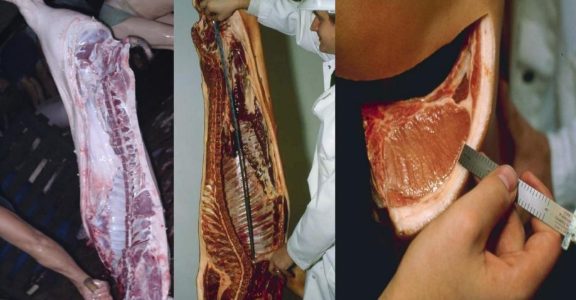In modern pig production, backfat thickness is more than a simple measurement of fat cover — it reflects the pig’s metabolic efficiency, carcass value, and even farm profitability.
While consumers and processors increasingly demand leaner pork, backfat still plays an essential role in defining texture, juiciness, and overall eating satisfaction.
The real challenge, therefore, lies not in minimizing fat, but in mastering the art of balance.
Why backfat still matters
For decades, the industry has viewed fat as waste — a by-product to be trimmed, reduced, or bred away. Yet science tells a different story: Backfat serves as a vital physiological reserve that supports energy balance, reproduction, and even meat quality.
In breeding herds, moderate backfat ensures that sows maintain reproductive efficiency, recover better post-lactation, and sustain body condition over multiple parities.
Too little fat can reduce conception rates and increase weaning-to-estrus intervals, while excessive fat increases the risk of dystocia and poor feed intake after farrowing.
In grower-finisher pigs, a moderate backfat layer contributes to carcass uniformity and desirable meat characteristics. Pork that is excessively lean often lacks marbling—the fine intramuscular fat that delivers tenderness and flavor.
The goal, therefore, is not to produce the leanest pig, but the one with the most efficient and market-appropriate carcass composition.
For most commercial genotypes, a P2 backfat thickness of 16-22 mm represents the sweet spot—balancing carcass yield, processing performance, and eating quality.
Deviations on either side of this range can directly affect profitability: leaner carcasses might fetch lower premiums, while overly fat ones reduce cutting yields and feed efficiency.
What shapes backfat deposition
1️⃣ Genetics: Breeding for balance
Genetic progress has dramatically reshaped carcass composition over the last two decades. Selection for lean gain and feed conversion efficiency has produced faster-growing, leaner pigs. However, ultra-lean lines often display higher stress sensitivity, lower intramuscular fat, and less juicy meat.
Modern breeding programs are now shifting focus toward balanced selection indices — optimizing lean meat yield without compromising fat cover and meat quality. Genetic markers linked to lipid metabolism and stress resistance are becoming valuable tools in this precision breeding approach.
2️⃣ Nutrition and energy density
Feed energy is the most direct driver of fat deposition. Diets rich in energy, particularly from fats or highly digestible carbohydrates, can accelerate adipose tissue development.
Conversely, overly restrictive feeding suppresses both growth and backfat formation, potentially leading to lower feed intake and poor carcass uniformity.
The energy-to-lysine ratio remains a critical nutritional tool for fine-tuning fat deposition. Precision in balancing digestible energy (DE) with amino acid density allows producers to control fat growth without sacrificing muscle deposition.
Additionally, incorporating functional oils and specific fatty acids can influence fat firmness and oxidative stability — aspects increasingly valued in premium pork markets.
3️⃣ Environmental and management factors
Thermal stress is another major influence on carcass fatness. During hot weather, pigs tend to eat less, redirecting energy toward maintaining body temperature instead of growth. The result is thinner backfat and variable carcass quality.
Modern housing systems with proper insulation, air circulation, and evaporative cooling can mitigate these losses. Moreover, consistent feed delivery, stocking density, and minimal stress handling contribute significantly to maintaining stable fat deposition patterns.
4️⃣ Gender and hormonal influence
Gender plays a defining role in backfat characteristics. Gilts generally deposit less backfat than barrows, attributed to hormonal and metabolic differences.
Adjusting dietary formulations to match gender-specific growth potential — for instance, slightly higher energy density for gilts — ensures uniform carcass outcomes and better feed efficiency across pens.
Precision nutrition: From estimation to real-time control
The integration of precision livestock farming (PLF) technologies has revolutionized how producers monitor and manage backfat. Tools such as real-time ultrasound scanners, automated feeders, and AI-based growth models enable producers to track fat deposition dynamically and adjust feeding programs accordingly.
By combining these technologies with data analytics, producers can implement individualized feeding strategies that optimize carcass composition while maintaining economic efficiency.
This shift marks a move from reactive nutrition to predictive management — ensuring every animal reaches its genetic potential within a defined market target.
The future: Fat as a functional indicator
Rather than viewing backfat as excess, the modern swine industry is beginning to treat it as a functional indicator — a sign of energy balance, welfare, and product quality.
Sustainable pork production depends on precision: aligning genetics, nutrition, and environment to create pigs that are both efficient and high-quality.
Ultimately, optimal backfat management reflects farm management excellence — where biology, technology, and economics intersect. Producers who understand and manage this balance will lead the industry toward higher profitability, better meat quality, and long-term sustainability.

